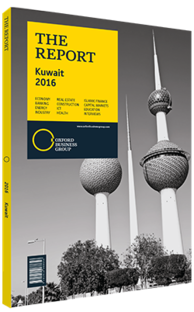Leveraging Kuwait's sovereign wealth
One of the major achievements of successive Kuwaiti governments has been the successful management of the wealth generated by its largest asset, oil. Starting in the 1970s and 1980s Kuwaiti leaders consolidated these resources under the ownership of publically owned entities, and the public coffers have benefitted enormously. Indeed, the steady influx of oil export revenue funds routinely finances about 90% of the country’s public spending. However, as oil prices have tumbled to their lowest level in over a decade, the structure of public revenues has begun to shift. Oil and gas revenues are set to decline from KD29.3bn ($96.9bn) to KD14.6bn ($48.3bn) between the 2013/14 and 2016/17 fiscal years, according to the IMF’s 2015 Article IV consultation for the country. Having presided over multibillion-dollar surpluses during the past decade, government officials are increasingly taking interest in how the country manages its sovereign wealth and are looking into opportunities to expand existent Kuwaiti assets.
A Larger Share
While oil income has fallen with crude prices, state revenues from investment income are set to rise steadily from KD4.4bn ($14.6bn) to KD4.9bn ($16.2bn) between the 2013/14 and 2016/17 fiscal years, according to the IMF. At that rate, investment income will double as a share of public revenue, growing from just over 12% to nearly 24% of the total over the same period. Kuwait’s investment income comes mainly from the country’s sovereign wealth fund, managed by the Kuwait Investment Authority (KIA). The institution traces its founding to the Kuwait Investment Board, established in 1953, and a 1982 law that made it an autonomous government body responsible for managing national wealth. With a variety of investments in assets including bonds, equities and real estate holdings totalling over an estimated $590bn, the KIA is the fifth-largest sovereign wealth fund in the world, according to figures from the US-based Sovereign Wealth Fund Institute.
Proposed Fund
While the KIA generated significant income for the country, the government is considering establishing a new sovereign wealth fund with $100bn in assets. The new fund would manage domestic assets currently administered by the KIA, local daily Al Anba reported in January 2016. The creation of the new fund could advance the government’s long-standing goal of privatising some state assets while also providing the KIA with an opportunity to focus on its international portfolio.
Kuwait’s government has for years discussed privatising state-held assets as a way to diversify revenue streams and introduce private participation into more areas of the economy. In May 2010 parliament approved a privatisation bill that was set to pave the way for the government to privatise state-owned entities, including some downstream energy assets. The plan called on the state to sell the shares it held and give Kuwaitis a chance to buy up to 40% of the privatised entities’ shares through initial public offerings. However, the 2010 plans stalled as the sale of major public assets such as Kuwait Airways faced delays while the Cabinet, parliament and other stakeholders weighed alternatives. Privatisation of the Kuwait Stock Exchange (KSE) has so far been successful, however, with the exchange now operated by the private Boursa Kuwait. The KSE’s transfer process is set to be completed by December 2016.
In addition, the proposed sovereign wealth fund could help the KIA focus on its international portfolio by taking over some of its domestic assets, including shares in local companies and utilities projects. The new fund would manage these assets with the goal of selling them at a profit in five to seven years. Whether the authorities decide to establish a new fund or not, the discussion of such a possibility highlights the important role wealth management and investment income are playing in the country’s fiscal policy as Kuwait adjusts to new realities in energy markets.
You have reached the limit of premium articles you can view for free.
Choose from the options below to purchase print or digital editions of our Reports. You can also purchase a website subscription giving you unlimited access to all of our Reports online for 12 months.
If you have already purchased this Report or have a website subscription, please login to continue.

